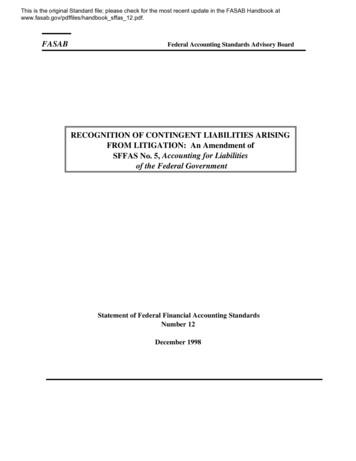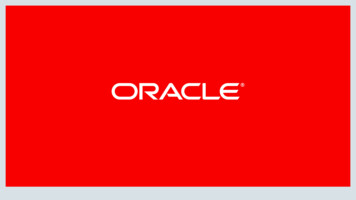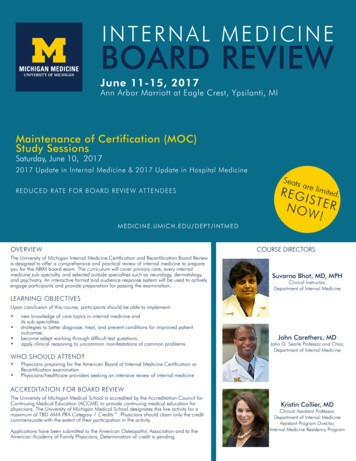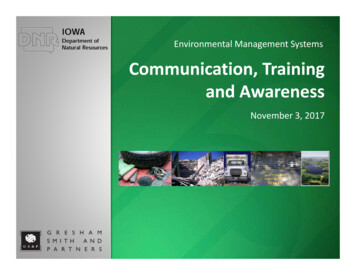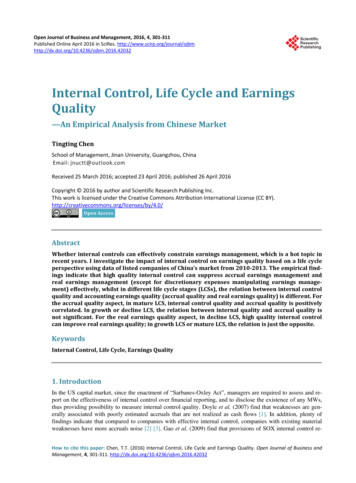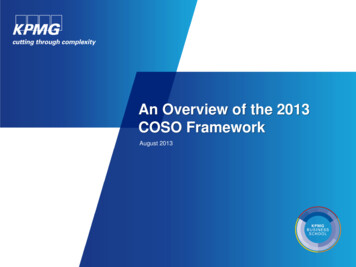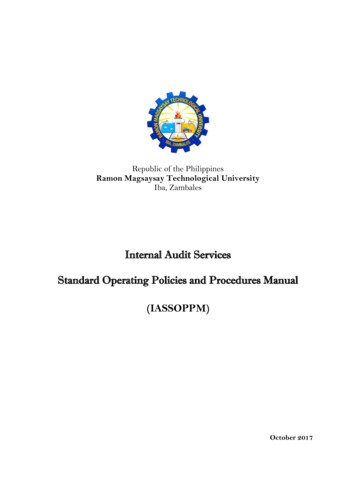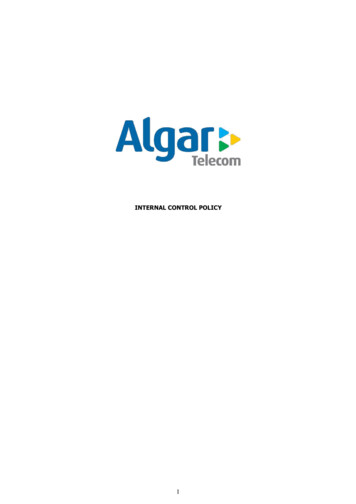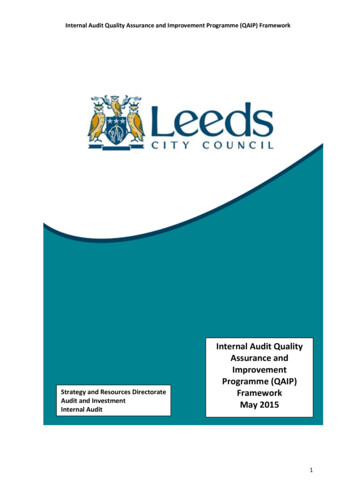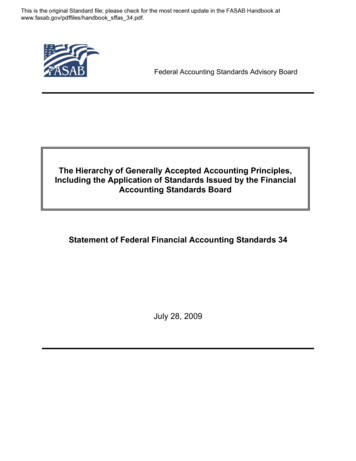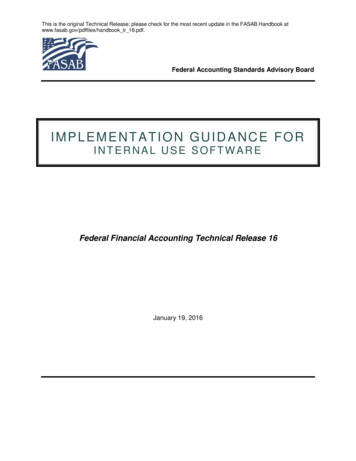
Transcription
This is the original Technical Release; please check for the most recent update in the FASAB Handbook atwww.fasab.gov/pdffiles/handbook tr 16.pdf.Federal Accounting Standards Advisory BoardIMPLEMENTATION GUIDANCE FORINTERNAL USE SOFTWAREFederal Financial Accounting Technical Release 16January 19, 2016
This is the original Technical Release; please check for the most recent update in the FASAB Handbook atwww.fasab.gov/pdffiles/handbook tr 16.pdf.THE FEDERAL ACCOUNTING STANDARDS ADVISORY BOARDThe Secretary of the Treasury, the Director of the Office of Management and Budget (OMB),and the Comptroller General, established the Federal Accounting Standards Advisory Board(FASAB or “the Board”) in October 1990. FASAB is responsible for promulgating accountingstandards for the United States Government. These standards are recognized as generallyaccepted accounting principles (GAAP) for the federal government.Section III. I (3) of FASAB’s Rules of Procedure authorizes the AAPC to issue TechnicalReleases related to existing federal accounting standards. Technical releases are intended toprovide guidance on the specific application of Statements of Federal Financial AccountingStandards (SFFASs), Interpretations of SFFASs, and Technical Bulletins. AAPC’s TechnicalReleases are in the third category of authoritative guidance in the Federal GAAP hierarchy asstated in the SFFAS 34, The Hierarchy of Generally Accepted Accounting Principles. AAPCmay not amend existing standards or promulgate new standards.Additional background information is available from the FASAB or its website: “Memorandum of Understanding among the Government Accountability Office,the Department of the Treasury, and the Office of Management and Budget, onFederal Government Accounting Standards and a Federal Accounting StandardsAdvisory Board.” “Mission Statement: Federal Accounting Standards Advisory Board”, exposuredrafts, Statements of Federal Financial Accounting Standards and Concepts,FASAB newsletters, and other items of interest are posted on FASAB’s websiteat: www.fasab.gov.Copyright InformationThis is a work of the U. S. government and is not subject to copyright protection in the UnitedStates. It may be reproduced and distributed in its entirety without further permission fromFASAB. However, because this work may contain copyrighted images or other material,permission from the copyright holder may be necessary if you wish to reproduce this materialseparately.Contact us:Federal Accounting Standards Advisory Board441 G Street, NW, Suite 6814Mail stop 6H19Washington, DC 20548Telephone 202-512-7350FAX – 202-512-7366www.fasab.gov
The Accounting and Auditing Policy CommitteeThe Accounting and Auditing Policy Committee (AAPC) was organized in May 1997 by theDepartment of the Treasury, the Office of Management and Budget (OMB), the GovernmentAccountability Office (GAO), the Chief Financial Officers' Council (CFOC), and the Council ofthe Inspectors General on Integrity and Efficiency (CIGIE), as a body to research accountingand auditing issues requiring guidance.The AAPC serves as a permanent committee established by the Federal Accounting StandardsAdvisory Board (FASAB). The mission of the FASAB is to develop accounting standards afterconsidering the financial and budgetary information needs of congressional oversight groups,executive agencies, and the needs of other users of federal financial information. The mission ofthe AAPC is to assist the federal government in improving financial reporting through the timelyidentification, discussion, and recommendation of solutions to accounting and auditing issues asthey relate to the specific application of existing authoritative literature.The AAPC is intended to address issues that arise in implementation, which are not specificallyor fully discussed in federal accounting and auditing standards. The AAPC's guidance iscleared by FASAB before being published.Additional background information on the AAPC is available from the FASAB or its website: Charter of the Accounting and Auditing Policy Committee Accounting and Auditing Policy Committee Operating Procedures
This is the original Technical Release; please check for the most recent update in the FASAB Handbook atwww.fasab.gov/pdffiles/handbook tr 16.pdf.This Page Intentionally Left Blank
TABLE OF CONTENTSExecutive Summary . 2Introduction . 3Purpose . 3Background. 3Related Accounting Literature . 4Technical Guidance . 5Scope . 5Applying Existing Standards to Current Development Models . 5Guidance on Applying SFFAS 10 to Certain New IUS Developments. 9Summary of Illustrations. 11Effective Date . 11Appendix . 12Appendix A: Basis for Conclusions . 12Project History . 12RESPONSES TO THE PROPOSAL. 14AAPC & BOARD APPROVAL . 14Appendix B: Illustrations . 15Illustrations B-1: Business Events and Deliverables for Software Development Phases . 15Illustrations B-2: Common Agency Practice . 19Appendix C: Abbreviations . 221TABLE OF CONTENTS FASAB
SUMMARYThis Technical Release (TR) assists reporting entities in implementing Statement of FederalFinancial Accounting Standards (SFFAS) 10, Accounting for Internal Use Software. SinceFASAB issued SFFAS 10 in 1998, software development practices have changed dramaticallyand reporting entities have experienced challenges applying the standards given the newterminology and techniques that have evolved. The TR provides implementation guidanceregarding:a. The definition of IUS, component/module based IUS assets, software developmentpractices including approaches that involve phases, and clarifying IUS recognition,measurement, and disclosure items (such as capitalized cost, capitalization cut off,capitalization threshold, enhancement, impairment, and related matters);b. New IUS challenges brought by changes in IUS development practices since theissuance of SFFAS 10; andc. Management's role in applying SFFAS 10.This objective of this guidance is to explain how to apply existing standards to the fast changingInternal Use Software (IUS) environment and help ensure that:a. Transactions involving IUS are recorded in accordance with federal accountingstandards.b. The cost of producing federal financial information, as it relates to capitalization orexpense of IUS cost, does not outweigh the benefits derived by the users of the financialinformation.2Summary FASAB
INTRODUCTIONPURPOSE1. This Technical Release (TR) assists agencies in applying SFFAS 10, Accounting forInternal Use Software, to the new software development practices that have evolvedsince FASAB issued the standard in October 1998. The TR considers the softwaredevelopment terms and practices that reporting entities utilize currently and helps clarifythe standards in light of those terms and practices. Specifically, the TR providesguidance regarding:a. The definition of internal use software (IUS), component/module based IUSassets, software development practices including approaches that involvephases, and clarifying IUS recognition, measurement, and disclosure items(such as capitalized cost, capitalization cut off, capitalization threshold,enhancement, impairment, and related matters);b. New IUS challenges brought by changes in IUS development practices since theissuance of SFFAS 10; andc. Management's role in applying SFFAS 10.2. This TR introduces new terms used in current development practices and defines themin light of the application of this guidance. It provides a discussion of issues andexamples to assist entity management in applying the principles described throughoutthe TR. The examples were selected because they were derived from underlyingtransactions or organizational characteristics rather than being attributable topreferences.3. The accounting standards and related basis for conclusions consistently recognizemanagement’s role in interpreting and applying generally accepted accounting principles(GAAP) within its operational environment. This TR recognizes that management isresponsible for establishing IUS accounting policies, methodologies, and for maintainingadequate documentation on the sources of data. It also recognizes that the cost ofproducing federal financial information, as it relates to capitalization or expense of IUScost, should not outweigh the benefits derived by the users of the financial information.BACKGROUND4. The software development life cycle has dramatically changed since the issuance ofSFFAS 10 in 1998. At that time the linear/waterfall1 software development practiceswere prevalent and characterized by three distinct life-cycle phases and long1The waterfall model is a sequential design process, used in software development processes, in which progress isseen as flowing steadily downwards (like a waterfall) through the software development phases.3Introduction FASAB
development cycles. Given the changes in development practices, technologicaladvances, and significant new development techniques and architectures,2 guidance forimplementation and sustainment of SFFAS 10 became critical.5. This TR introduces new IUS development terms and defines them to aid in applyingexisting standards. The definitions provided are not all encompassing but are included topromote greater understanding, and more consistent application and implementation ofthe standards. The same principles used to develop the guidance on the current IUSdevelopment practices could be used for future IUS development practices. Thebusiness events and deliverables table and agency practice examples are provided inAppendix B. These examples are intended to illustrate use of professional judgment inthe development and application of policy and practices to account for IUS inaccordance with GAAP. The examples are not all encompassing and reporting entitiesmay identify other more useful and relevant methodologies. Users of this guidanceshould use these examples to develop their own reasonable business processes.6. This TR was developed to aid in meeting the operating performance reporting objectiveidentified in Statement of Federal Financial Accounting Concepts (SFFAC) 1, Objectivesof Federal Financial Reporting, paragraph 143: Federal financial reporting should assistreport users in evaluating the service efforts, costs, and accomplishments of thereporting entity; the manner in which these efforts and accomplishments have beenfinanced; and the management of the entity’s assets and liabilities. Federal financialreporting should provide information that helps the reader to determine:a. The costs of providing specific programs and activities and the compositions of,and changes in, these costs;b. The efforts and accomplishments associated with Federal programs and thechanges over time and in relation to costs; andc. The efficiency and effectiveness of the Government’s management of its assetsand liabilities.RELATED ACCOUNTING LITERATURE7. The related accounting literature is:a. SFFAC 2, Entity and Displayb. SFFAS 4, Managerial Cost Accounting Concepts and Standards for the FederalGovernmentc. SFFAS 5, Accounting for Liabilities of the Federal Governmentd. SFFAS 6, Accounting for Property, Plant, and Equipmente. SFFAS 10, Accounting for Internal Use Softwaref. SFFAS 35, Estimating the Historical Cost of General Property, Plant, andEquipment: Amending Standards of Federal Financial Accounting Standards 6and 232Such as cloud service, shared service, agile development, and spiral development with a focus on module baseddevelopment and shorter development cycles.3This principle was also relied upon in Office of Management and Budget (OMB) Circular A-11 Preparation,Submission, and Execution of the Budget; Supplement to Circular A-11, Capital Programming Guide (July 2014),Page 61.4Introduction FASAB
TECHNICAL GUIDANCESCOPE8. Readers of this Technical Release (TR) should first refer to the hierarchy of accountingstandards in Statement of Federal Financial Accounting Standards (SFFAS) 34, TheHierarchy of Generally Accepted Accounting Principles, including the Application ofStandards Issued by the Financial Accounting Standards Board. This TR supplementsthe relevant accounting standards, but is not a substitute for and does not takeprecedence over the standards. This TR clarifies but does not change guidanceprovided in SFFAS 4, 5, 6, 10, and 35.9. This TR rescinds TR5 Implementation Guidance on Statement of Federal FinancialAccounting Standards 10: Accounting for Internal Use Software.10. This TR applies to all internal use software that meet the definition of IUS as describedin SFFAS 10 including the following:a. Software to be used in research and development where the software will havean alternate future useb. Software developed separately and installed on a number of different generalproperty, plant, and equipment (PP&E) assets at different times4APPLYING EXISTING STANDARDS TO CURRENT DEVELOPMENTMODELS11. IUS Definition: SFFAS 10, paragraphs 8 – 9, defines “internal use software” as softwarethat is “purchased from commercial vendors off-the-shelf (COTS), internally developed,or contractor-developed solely to meet the entity’s internal or operational needs.” TheIUS development or modification can be performed by employees of the entity orcontractors that the entity is paying to design, program, install, and implement. Softwareassets need to be evaluated for ownership to determine which entity is ultimatelyresponsible for reporting the asset.12. Development Phases: SFFAS 10 presents three phases of software development thatfollow a linear approach to an IUS project: the preliminary design phase, the softwaredevelopment phase, and the post-implementation/operational phase. It states that costsincurred during the development phase should be capitalized, while the costs incurred inother phases should be expensed. However, software may not always be developedunder this linear approach and capitalization decisions absent distinct phases are moredifficult. Regardless of timing, the cost incurred for development phase activities should4SFFAS 10, paragraph 22, provides that computer software that is integrated into and necessary to operate generalPP&E, rather than perform an application, should be considered part of the PP&E of which it is an integral part andcapitalized and depreciated accordingly. However, computer software could be developed separately and installedon several general PP&E assets at different times. For example, anti-ballistic missile software installed on multipleradar systems at different times can be treated as a separate IUS asset if the software meets the capitalizationthreshold.5Technical Guidance FASAB
be capitalized or expensed based on provisions of SFFAS 10 and considering thesubstance of the activity.13. Capitalized Cost: The full cost (direct and indirect cost as stated in SFFAS 4, paragraph89, 90, and 91) incurred during the software development phases should be capitalized(SFFAS 10, paragraph 16 thru 18). Considering economic feasibility, a cost estimationtechnique could be developed to trace the costs to outputs based on the SFFAS 4,paragraph 124, provision that “[in] principle, costs should be assigned to outputs in oneof the methods listed below in the order of preference:a. Directly tracing costs wherever economically feasible;b. Assigning costs on a cause-and-effect basis; andc. Allocating costs on a reasonable and consistent basis.”14. A specific software development project may include expenditures for improvements andmaintenance that cannot be easily separated but may be reasonably and consistentlyallocated. One approach that can be used is a ratio based on the projected work hoursfor development phase activities relative to other types of work. Such a ratio can beapplied to determine the expenditures that should be capitalized. The basis for allocatingcosts should be consistent with applicable standards and defensible.15. Capitalization Cut Off: SFFAS 10, paragraph 20, states, “Costs incurred after finalacceptance testing has been successfully completed should be expensed. Where thesoftware is to be installed at multiple sites, capitalization should cease at each site aftertesting is complete at that site.” In some development practices, each iteration5 within anIUS development has its own acceptance testing before moving forward to the nextiteration and final acceptance testing may not always be performed. The entity shouldidentify a pre-determined agency milestone such as the go-live or in-service date whichis equivalent to a final acceptance test for capitalization cut off purposes.16. Integrated Software: SFFAS 10, paragraph 22, states, “Computer software that isintegrated into and necessary to operate general PP&E, rather than perform anapplication, should be considered part of the PP&E of which it is an integral part andcapitalized and depreciated accordingly (e.g., airport radar and computer-operatedlathes). The aggregate cost of the hardware and software should be used to determinewhether to capitalize or expense the costs.” In situations where software and thehardware on which it runs have independent service lives, the determination of theuseful life of the software should be viewed independently of the useful life of thehardware. This determination should be made on a case by case basis for each entityand is at the discretion of management of the entity. The rationale for this determinationshould be documented.17. Component Based IUS Asset: SFFAS 10, paragraph 33, states, “For each module orcomponent of a software project, amortization should begin when that module or5Iteration is the act of repeating a process with the aim of approaching a desired goal, target or result. Eachrepetition of the process is also called an "iteration," and the results of one iteration are used as the starting point forthe next iteration.6Technical Guidance FASAB
component has been successfully tested. If the use of a module is dependent oncompletion of another module(s), the amortization of that module should begin whenboth that module and the other module(s) have successfully completed testing.” Forexample, an entity may develop an accounting software system containing threemodules: a general ledger, an accounts payable sub-ledger, and an accounts receivablesub-ledger. In this example, each module could be analyzed to determine whether itcould be treated as a separate asset. Specifically, if the module provides economicbenefit through distinct, substantive functionality; and meets the tests for capitalizationthreshold, ownership, and eligibility for capital treatment, then the module could betreated as a separate IUS asset for the purposes of recognition, measurement includingamortization, and disclosure in accordance with SFFAS 10.18. Capitalization Threshold: SFFAS 10, paragraph 24, states, “Each federal entity shouldestablish its own threshold as well as guidance on applying the threshold to bulkpurchases of software programs (e.g., spreadsheets, word-processing programs, etc.)and to modules or components of a total software system.” When establishing thecapitalization threshold for IUS, the federal entity should include both qualitative andquantitative considerations as stated in SFFAC 2 paragraph 46. Qualitativeconsiderations could be applied to IUS assets that require special management attentionbecause of their importance to the agency mission; high development, operating, ormaintenance costs; high risk; high return; or their significant role in the administration ofagency programs, finances, property, or other resources.619. When establishing a capitalization threshold for bulk software purchases, the thresholdshould not be based on unit price. The organization should consider the bulk value anduseful life established by the organization to avoid materially distorting period costs andunderstating asset values.20. OMB notes that a stratified capital programming process involving more or less detailand review based on the size or strategic importance of proposed investments may beappropriate, particularly in large agencies.7 Similarly, more than one capitalizationthreshold could be established for different components of a large agency. Agenciesshould have well documented thresholds clearly disseminated and implemented acrossthe organization.21. Enhancement: SFFAS 10, paragraph 25, states, “The acquisition cost of enhancementsto existing internal use software (and modules thereof) should be capitalized when it ismore likely than not that they will result in significant additional capabilities.” Significantadditional capabilities are modifications to existing IUS that result in additionalfunctionality—that is, modifications to enable the software to perform tasks that it waspreviously incapable of performing. As stated in SFFAS 10 paragraph 26, capitalizableenhancements normally require new software specifications and may also require achange to all or part of the existing software specifications. Examples of enhancementscould include augmenting existing business functions with new features and functions,developing additional new business functions, and/or adding new functionality andcapability.6OMB Circular A-11 Preparation, Submission, and Execution of the Budget; Supplement to Circular A-11, CapitalProgramming Guide, Threshold for Capital Programming, page 2, July 2014.7See note 6.7Technical Guidance FASAB
22. If one module is dependent upon another to function, then those modules should beevaluated together as one enhancement. All costs of an enhancement, including anycosts carried over or allocated from the original software, should be amortized over theenhancement's estimated useful life.23. Impairment: SFFAS 10, paragraphs 28-30, addresses how to determine if software isimpaired during the post-implementation operational phases and the measurement ofthe impairment for the impaired software remaining in use or to be removed. Significantevents or changes in operating circumstances warrant a review to determine whetherthe carrying value of an existing software asset is not recoverable and should beimpaired. An assessment should be performed to determine the remaining useful life ofthe impaired software for amortization purposes.24. When it is more likely than not that a developmental software project will not becompleted, no further costs should be capitalized and any costs that have beencapitalized should be written off in accordance with SFFAS 10, paragraph 31. Indicationsthat the software may no longer be completed include:a. The expenditures are neither budgeted nor incurred to fund further development;b. The discontinuance of the business segment the software was designed for;c. The inability to resolve programming difficulties timely; ord. A decision to obtain COTS instead and abandon the current softwaredevelopment25. When a developmental software project is suspended pending management’s evaluationas to whether to resume or terminate the project, the software development cost mayremain capitalized as long as it is more likely than not 8 that the developmental softwareproject will eventually be completed and the cost incurred or expected to be incurredmeets the capitalization threshold. The status of the project should be reevaluatedperiodically and the capitalized cost should be written off if management concludes thatit is more likely than not that the software will not be placed into service in the future.26. Software License: If the term of software license(s) is 2 years or more with periodicpayments, the license should be evaluated against lease criteria as stated in SFFAS 5paragraphs 43-46 and SFFAS 6 paragraph 20 to determine if it is a capital or operatinglease. If the license(s) is perpetual with an upfront cost9 to use the software for its entirelifetime, then the entity is purchasing IUS and should apply its existing policy forcapitalization thresholds to determine if the license should be capitalized or expensed.27. A license agreement may include executory costs for maintenance and technicalsupport. Agency judgment should apply in determining what portions of license fees areattributable to software capitalizable costs versus executory costs. Assuming leasecapitalization criteria and thresholds are met, software license capitalization amounts10may be derived from the payment schedule contained in the license agreement. Asstated in SFFAS 5, if the portion of the minimum lease payments representing executory8SFFAS10, paragraph 31, provides for write off if it is more likely than not that the project will not be completed andplaced in service.9The cost could be charged as a one-time payment or financed over a set period of time.10SFFAS 5, paragraph 44.8Technical Guidance FASAB
cost is not determinable from the lease provisions, the amount should be estimated.Agencies may also want to consider having each license agreement specifically identifythe various costs throughout the license lifecycle, for example, initial license,maintenance, and enhancement.GUIDANCE ON APPLYING SFFAS 10 TO CERTAIN NEW IUSDEVELOPMENTSCloud Computing28. A cloud computing service is a resource provided over the Internet that has the followingessential characteristics: on-demand self-service, broad network access, resourcepooling, rapid elasticity, and measured service. The most common cloud serviceresources are: software as a service, platform as a service, and infrastructure as aservice.1129. If a cloud computing arrangement includes a software license, the customer shouldaccount for the software license element of the arrangement consistent with theacquisition of other software licenses in accordance with the lease criteria stated inSFFAS 5 and SFFAS 6, and as discussed in paragraph 26 of this TR. SFFAS 10 is notapplicable to a cloud computing arrangement that does not convey a contractual right tothe IUS or to ones that do not include an IUS license. The entity that develops and ownsthe software, platform, or infrastructure that is used in the cloud computing arrangementwould account for the software development in accordance with SFFAS 10. If thefunding to develop cloud computing is shared among entities without clear ownership,the service provider entity that receives funding and is responsible for maintaining thesoftware, platform, or infrastructure should account for the software in accordance withSFFAS 10 and the full cost/inter-entity cost requirements of SFFAS 4Shared Services30. Shared Service means a mission or support function provided by one business unit toother business units within or between organizations. The funding and resourcing of theservice is shared and the providing entity effectively becomes an internal/externalservice provider. There are three types of shared service structures in the federalgovernment: intra-agency, interagency and commercial. Intra-agency shared servicesinclude those provided within the boundaries of a specific organization such as a federaldepartment or agency, to that organization’s internal units. Interagency shared servicesare those provided by one federal organization to other federal organizations that areoutside of the provider’s organizational boundaries. Commercial shared services arethose provided by private vendors.1211The full definition is available at The National Institute of Standards and Technology: The NIST Definition of CloudComputing, Special Publication 800-145, September 2011.12Chief Information Office Council: Federal Shared Service Implementation Guide, April 2013, and OMB M-13-08:Improving Financial Systems Through Shared Services, March 25, 2013.9Technical Guidance FASAB
31. For intra-agency shared services, a cost allocation methodology could be developed inaccordance with SFFAS 4, paragraphs 120-125. For interagency shared services andcommercial shared services, the service provider entity that owns (receivesfunding/responsible for maintaining) the software should account for the software inaccordance with SFFAS 10. In the event that the entity receiving the service (thecustomer) has the contractual right to take possession of the software at any time duringthe hosting period without significant penalty, and it is feasible for the customer to eithe
10. This TR applies to all internal use software that meet the definition of IUS as described in SFFAS 10 including the following: a. Software to be used in research and development where the software will have an alternate future use b. Software developed separately and installed on a number of different general
